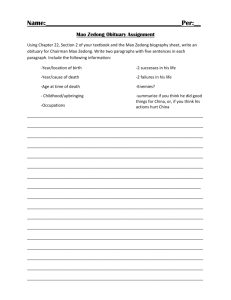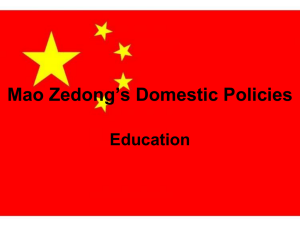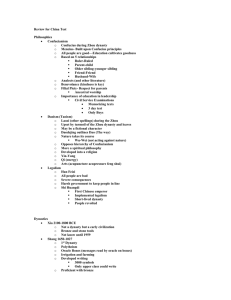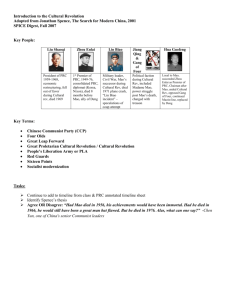How Chinas biggest attempt for modernisation failed
advertisement
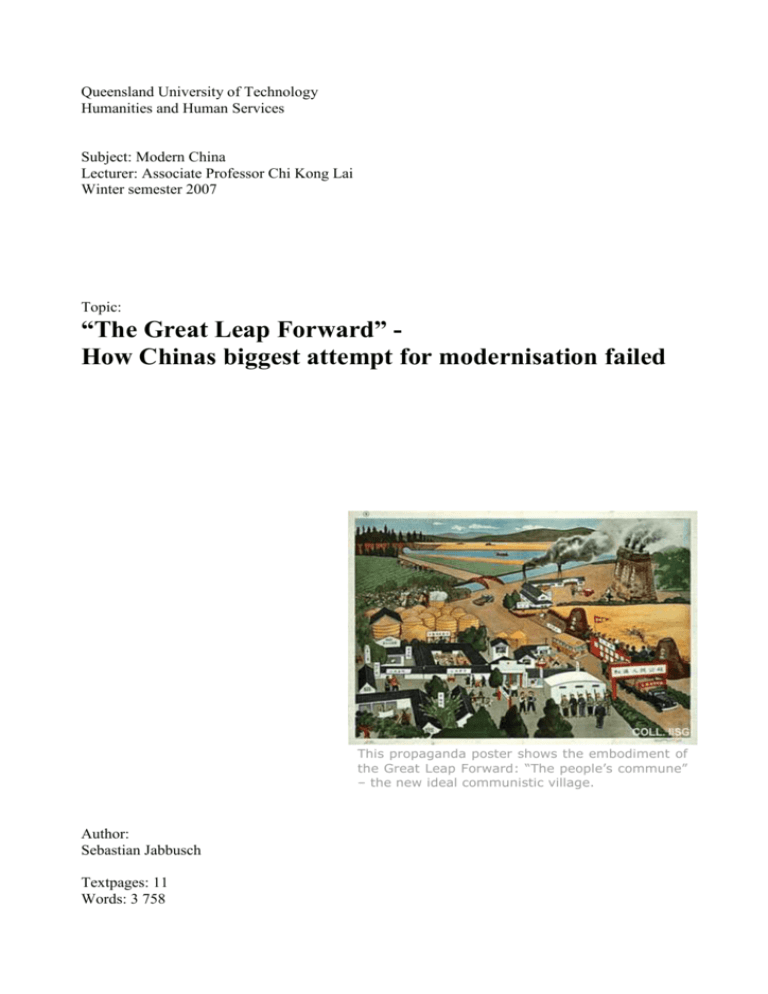
Queensland University of Technology Humanities and Human Services Subject: Modern China Lecturer: Associate Professor Chi Kong Lai Winter semester 2007 Cover sheet Topic: “The Great Leap Forward” How Chinas biggest attempt for modernisation failed This propaganda poster shows the embodiment of the Great Leap Forward: “The people’s commune” – the new ideal communistic village. Author: Sebastian Jabbusch Textpages: 11 Words: 3 758 “ Quotes Between the spring of 1959 and the end of 1961 some 30 million Chinese starved to death and about the same number of births were lost or postponed.1 Since pigs, too, were starving […], they were let out and allowed to roam the communal latrines. As the commune members squatted there, swollen with malnutrition and constipated from the grim diet, the pigs would jostle them with their snouts, trying to get at the excrement before it had even fallen from their bodies. 2 „ 1 (Smil, Vaclav 1999: China’s great famine – 40 years later. In: BMJ, Vol. 319/18.-25.12.99, pp. 1619-1621.) (Spence 1990: 552; quoting Yue Daiyun, with Carolyn Wakeman, To the Storm: The Odyssey of a Revolutionary Woman (Barkeley: University of California Press, 1985), pp. 80 and 82) 2 2 Outline COVER SHEET............................................................................................................................................................1 QUOTES ........................................................................................................................................................................2 ABSTRACT ...................................................................................................................................................................4 I. INTRODUCTION .............................................................................................................................................6 II. HISTORIC PLACEMENT..........................................................................................................................7 1. 2. 3. 4. COMMUNISTS TAKE OVER ..............................................................................................................................7 LAND REFORM ..................................................................................................................................................7 COLLECTIVISATION ........................................................................................................................................7 THE GREAT LEAP FORWARD.........................................................................................................................9 III. ARGUMENTATION – WHAT WENT WRONG? ...........................................................................10 1. 2. A. B. C. D. E. 3. A. B. C. 4. 5. 6. 7. COLLECTIVISATION ......................................................................................................................................10 COMMUNES .....................................................................................................................................................10 DECENTRALISATION AND LOSS OF POLITICAL CONTROL...............................................................................10 MANAGEMENT ...................................................................................................................................................10 MESS HALLS .....................................................................................................................................................11 DESTRUCTION OF TRADITIONAL FAMILY LIFE ................................................................................................11 END OF PRIVATE PROPERTY .............................................................................................................................12 MASS CAMPAIGNS.........................................................................................................................................12 BACKYARD STEAL PRODUCTION......................................................................................................................12 SPARROW CAMPAIGN .......................................................................................................................................13 BIG PROJECTS ..................................................................................................................................................13 INFLATION ON HARVEST RESULTS ............................................................................................................13 FALSE CULTIVATION.....................................................................................................................................14 FEAR TO CRITIC .............................................................................................................................................15 MILITARIZATION ..........................................................................................................................................15 IV. CONCLUSION ............................................................................................................................................16 REFERENCES............................................................................................................................................................17 3 Abstract “The Great Leap Forward” - How Chinas biggest attempt for modernisation failed This essay critically examines the most important reasons for the failure of Chinas big development campaign the “Great Leap Forward”. The Leap was a political campaign by communist party leader Mao Tse-tung from 1958 - 1960, designed to catch up with the western world within a short time. This essay concentrates on the misleading agricultural politics, which were introduced too rapidly and led to the greatest man-made famine and an estimated death toll of about 20 – 30 million people. The research reveals a long list of interacting mistakes in planing and enforcing the different campaigns and policies. The combination and interactions between ineffective farming, widespread fear to critic grievance, abolishment of traditional family life, introduction of mismanaged communes and the dispatch of peasants during harvest and seeding periods can be seen as main reasons for the failure. Chinese people died not despite of Mao’s politics, but because of them. 4 Abbreviations GLF = Great Leap Forward CCP = China’s Communist Party PRC = People’s Republic of China BSF = backyard steal funerals 5 I. Introduction Thirty to forty million people died in China in the biggest man-made famine ever3. This occurred precisely at that time, when China tried to modernise and catch up with the developed world. The time from 1958 to 1962 was named after Mao Tse-tung’s famous campaign: The “Great Leap Forward” (GLF), which affected almost a sixth of humankind. However, in fact, it was a great leap backwards. Beside the massive death toll, agriculture production was reduced, the party structure weakened, the peoples euphoria turned into frustration and the central planning captaincy lost in regional chaos. It also led to the breakdown of the China-Soviet alliance and a grave internal economic crisis and a power struggle within the country. After a historic placement, this essay will focus on the main mistakes in planning and empowering the GLF. The positive aspects, at least those few, and the natural weather impacts are not considered in this paper. This essay concentrates on the time of the GLF from 1957 to 1961. It is based mostly on Maurice Meisner’s book “Mao’s China – the Story of the People’s Republic” as well as the book “Chinese Village, Socialist State” by Friedmann, Pickowicz and Selden4. I will prove that there has obviously been a huge gap between aims and outcome. The GLF turned from one of the most ambitious programs in human history into a big economic and social crash. 3 They died through exhaustion, illnesses and malnutrition. Extreme assumptions go up to 60 million (see Smill 1999: 1619) or down to less than five million (see Ball 2006: 1). The academic debate, how many people exactly died and what percentage of the death toll were due to natural causes through bad weather and how much was though the GLF policies cannot be fully reflected here. For that debate, I recommend William A. Joseph’s article “Post-Mao Views of the GLF”. 4 To keep the citation short, only Friedman will be named in this essay. 6 II. Historic placement 1. Communists take over After a long civil war, the Communists under the lead of Mao Tse-tung finally took over in 1949. His opponent Chiang Kai-shek and leaders of the National party fled to Taiwan. The Communists united whole China for the first time since 1925 and established the People’s Republic of China (PRC). The power of the Communists – different to the communist revolution in Russia – was not based on the city but on the countryside5. Mao described the poor peasants as the “vanguards of the revolution” (McLellan 1979: 222). Now with the new Republic Mao, son of a farmer (Winsbury 1978: 65), wanted to fulfil his promises: “Land to the tiller”, the end of exploitation of the peasants through the gentry land-lord class. China’s rural population represented 70 % of the total 500 million people at that time and still lived in a feudal society (see Pryor 1992: 28). 2. Land reform As the first step the Communists planed a land reform, in which land from the gentry and churches was distributed to poor or landless peasants. The Agrarian Reform Law was passed in June 1950 and carried out within two years. In that progress, nearly half of Chinas cultivated land was redistributed (see Meisner 1979: 109). Communists called it a “social revolution”, but according to the experiences from Russia, China tried to avoid violence6 to keep food supply stable. Compared with the GLF the land reform brought benefits for millions of peasants, was wisely planed and carefully implemented, although egalitarianism was not achieved. The land reform also achieved no economic benefits. Therefore, the ongoing poverty remained unsolved. For a detailed description, see Chapter 8 of Meisner (1979). 3. Collectivisation After the land reform, China’s peasants were satisfied. They lived in a “relatively” egalitarian society, on individually owned family farms. The same time there was no civil war, no warlords, no mortgages or similar threats (see Meisner 1979: 140). 5 There the Communists have been hiding during the civil war, there they had their base and their main support. Although the progress got more aggressive in the late 1950 it remained quiet and peaceful compared with the progress in Russia. 6 7 But for the Communist Party land reform was only the first step to communism. They saw important problems unsolved: - Without efficient agriculture, developmental plans for industrialisation would suffer, too. However, the slow growth in agriculture7 hardly kept up to the population growth (see Meisner 1979: 141). This put the five-year plan into danger. - The large number of small farming units and greater fragmentation made improvements through mechanisation impossible (see Meisner 1979: 109). - Mao was convinced bigger teams and working on large scale fields would be more efficient (see McLellan 1979: 238). - One major concern was “capitalism”8. Communists feared that the rural economy would develop traditional forms of exploitation and could reproduce old patterns of socio-economic differentiation after very short time9 (Meisner 1979: 141). The logic consequence was collectivisation. In the beginning, the Chinese started a careful implementation in three steps (see Meisner 1979: 141, 142 and Unger 2002: 8): 1. “Mutual aid teams”: members of about six or more households assist each other. Property and income still private. 2. Mutual aid teams were later combined into “semi-socialist” or “lower” agriculture producer cooperatives (two dozen families), under a lot of political pressure and propaganda. Land was pooled and farmed cooperatively. Each family kept private ownership of the land but divided the crop partly in accordance to labour and property. 3. In the last step10, lower cooperatives combined into “higher” or “advanced” cooperative farms with 40 to 200 households (known as “collectives”). Private land was abolished. Income was distributed only according to labour. The Communist leadership intensively discussed the timetable for collectivisation. Some feared rallies and resistance11. The majority claimed that collectivisation makes no sense without modern machinery12. Nevertheless, in July 1955, Mao Tse-tung ignored the consensus 7 While industrial output rose at about 18.7 percent per year during the first five-year plan period, agricultural production rose only about 3.8 percent. 8 Mao said forces tending to develop “spontaneously towards capitalism” (Brugger 1979: 160). 9 Four freedoms remained from the land reform, were seen as a problem: “freedom of purchase, sell and rent land; to hire agricultural labours, to lend money and to engage in trade on private market” (see Meisner 1979: 144). 10 Later the cooperative was forced directly without consideration of the steps one and two. 11 Chinas leaders were well aware, that Stalin murdered or deported more than 10 million people during the collectivisation (see Meisner1979: 147). 12 Machinery – except from some tractors from the Soviet Union – as well as a modern industry and technicians who can develop them were not yet available. Even Mao thought this would need at least three five-year plans (see Meisner 1979: 142). 8 for a slow and voluntary development and launched the campaign for collectivisation with his speech on “The Question of Agricultural Cooperation”. Collectivization was fulfilled in a rapid rush under pressure but surprisingly largely without violence (see Meisner 1979: 154). Until 1957 virtually all peasant households had joined the “higher-stage agricultural producer cooperatives”13. However, while a lot of organisational problems, like missing collective barns, were not yet solved, Mao launched the next revolutionary campaign. 4. The Great Leap Forward The “Great Leap Forward” was the name of the second five-year plan from 1958-1963, although the term in historical context (and in this essay) is usually limited to the first three years of this period, because in 1961 the CCP left the economic course. Although the capitalist threat of private landownership was solved by collectivisation (see 2.3), economic improvements had not been achieved yet. For Mao socialization of agriculture was the only chance “to throw off poverty” (Meisner 1979: 159). The central idea behind the GLF was a rapid development of China in agriculture and industry within the same time14 “just” by using the masses as cheap labour, the enthusiasm for socialism (see Brugger 1978: 158) and heroic working through human will (see Spence 1990: 546). One of the main elements was the establishment of the huge communes, which merged the existing collectives. In 1958 in extreme rapid development circa 24.000 communes with an average 5000 households15 were established (see Meisner 1979: 233). The communes were established as the new basic level of administration and were supposed to be relatively self-sufficient. However, communes not only implied a greater organisational level, but also rapid social changes in the peasant’s traditional life. The Communists abolished private plots and labour, and established mess halls and other free public services. The aim was to replace the traditional family structure. Beside a massive increase in grain production Mao put much effort in rural light industry development. The “backyard steal funerals” (BSF) were supposed to help to double Chinas steal production within one year and to catch up with the UK within fifteen years. 13 The former “lower” cooperatives remained as production brigades within the new collectives. The first five year plan has been concentred on the development of the heavy industry and spends only very little attention to the development of the rural area. 15 An average commune comprised 5,000 households (approximately 30,000 people, with variations from 5,000 to 100,000 people). 14 9 III. Argumentation – What went wrong? In the following chapter, I try to highlight the most important failures of the GLF. 1. Collectivisation Collectivisation was not even full implemented when the GLF started. Unsolved problems were brought into the communes. Richer peasants resented16 about the economic level, which was due to amalgamation with peasants from poorer or less efficient farms. After the revolutionary diligence disappeared within the first months, peasants came only arbitrary to work– like in other communist countries. The work-point system performed inefficient. The inequalities in remuneration helped the motivation to decline even more. Collectives got precise plans for their fields. They were required to ignore comparative advantage and market prices and to concentrate on the production of low-priced grain (Unger 2002:12). 2. Communes a. Decentralisation and loss of political control Although a central economic planning still remained, Mao gave the communes more freedom to “develop creative solutions”. This decentralisation was supposed to lead to local initiatives that brought the creativity of the masses into the production. This theoretically good idea got in conflict with the military discipline Mao also demanded. In fact, the discipline and the huge size of the communes made creative solutions even more complicated than it had been in the collectives. The results of high independence of the communes influenced even worse. After the loss of control, the central government had to face a general breakdown of national economic planning and coordination. That led to gross inefficiencies in the production and distribution of goods and materials. The missing bureaucracy was one of the reasons for the neglecting of the famine by Mao. b. Management The communes had been built up too rapidly. There was no exact plan of what to do. Much of what happened was largely spontaneous. Meisner (1979: 231) writes: “[It was a] complex interplay of spontaneous radicalism of rural cadres and poor peasants from below with the radical utopianism of Mao and Maoist from above.” There was a general uncertainty 16 Many peasants affronted official regulations, e.g. slaughtering and consuming farm animals instead of turning them over to the commune. 10 about how to operate the new organisations. The party cadres were not trained17 or specially instructed. There was also a special lack of skilled employees to properly manage the complex fiscal affairs of the commune and the new social facilities. “The realities of the communization bore little resemblance to the principles of the rational utilization of labour upon which the GLF originally was based.” (Meisner 1979:237) c. Mess halls Family food cooking or storing of food was forbidden. With the new communal mess halls, food was available every time. Also very problematic was the fact that food was contributed through a work-point system, which in fact did not work. In addition the party leaders decided in late 1958 that food (and income) should be contributed 70 % in relation to the needs and only 30 % in relation to labour. In some communes, eating was free of any charge at all. Altogether, that leads to higher food consumption. In combination with unskilled mess hall managers, who did not ration the food, this led quickly to empty kitchens. d. Destruction of traditional family life The communes were designed to abolish traditional family life. Nurseries, kindergartens, mess halls, laundries and homes for elders were supposed to free the women from housework. This had two effects. On the one hand, new work forces went to the fields. There they partly replaced18 the skilled peasants. However, the unskilled women (and other worker) were often not trained and therefore even counterproductive19. The other effect was the loss of household food management. To diminish family life they also reduced the so important20 (see Unger 2002: 15) family plots (small piece of their old property) and increased the scale and intensity of collective labour to physical limits (and sometimes even more). The most important fact about destruction of family life is the decline of motivation of peasants21. To work hard and act economically for the own family is much easier than for an abstract system. 17 In Ruoyang e.g. officials commanded to change the planting in the middle of the summer. But this was to late – the whole crop was destroyed. Woman cried while they were forced to cut down crops in order to grow potatoes (see Friedman 1991: 232). 18 Many peasants were send to big contraction projects or into small-scale steal production. 19 If for example the roots were not pulled up slowly by hand, they are not loosening the soil. This is import for the next seed. Consequently the poor harvest of 1958 augured not only an immediate decline, but also a poor next crop from bad seeding (see Friedman 1991: 228). 20 On the one hand they provide an important part of the income. On the these private lands were the main producer of vegetable and small animals, like chicken and ducks. 21 But it must be mentioned that motivation was only very small problem. Propaganda, shock brigades and military discipline replace own motivation. Often people died just of exhaustion. 11 e. End of private property At the end of 1958 all the rest of private property (about seven percent of all cultivated land) was brought into the ownership of the communes (see Meisner 1979: 143). In some communes everything from cooking utensils, furniture and watches were collectivised (see Meisner 1979: 236). Private selling of agricultural goods had already been abolished in 1954. In addition, private rural markets closed down. With them accessible food disappeared. Instead, exhausted people had to walk sometimes up to five days to the next commune centre (Friedman 1991: 230). This made the distribution of goods, especially in the poor mountains in the rural areas, even more complicated. 3. Mass campaigns Mao believed that with the proper ideological guidance “unutilised or underutilised labour potential of the people could be released and mobilised into a vast crusade to conquer nature“(Meisner 1979: 221). Therefore, the Communists started different propaganda campaigns. I would like to pick up three devastating ones: a. Backyard Steal production The BSF campaign is a good example how a good idea (rural light industry development) can be fatally implemented22. Mao believed that massive steal production is the essential key for modernisation. In Hunan, a village where the commune model was tested, the first rural furnaces were built. When Mao visited the village high-quality steal, which was produced somewhere else, was presented to him. Obviously, Mao did not know that steal could only be produced with huge furnaces and with the use of coal, which can deliver the necessary heat. Anyway, he decided – without any further consultation – to start a campaign that made it compulsory for every Chinese to melt steal in his backyard. It is estimated that about at least 19 million people took part (see Friedman 1991: 227) in building and running about one million (see Spence 1990: 550) BSF. The steal they produced by melting old metal was useless. It was an enormous waste of labour. A waste of material as well: To build the funerals they used brigs and stones from temples and even schools. They melted every metal they had: train-rails, agricultural tools and even pots and pans23. In addition, to get the fire burning, they cleared woods and even used furniture (see Friedman 1991: 227, 228). 22 Most but not all plans went wrong: Other small-scale undertakings, like local chemical and fertilizer factories and coal mines in the rural areas often highly effective in meeting immediate needs and yielding long-term technological innovations. China build 6 million commune factories, about 125 new factories per commune in one year (Friedman 1991: 227). 23 Teams from the cities were sent to put pressure on villagers to give all their metal “waste” (Friedman 1991: 227). 12 b. Sparrow campaign The sparrow campaign aimed to kill birds, which were seen as a pest, because they pick up the seed from the fields. With the help of the masses, Mao tried to reduce the population. People were told to kill them where ever they can. On campaign-days hole villages were sent into the woods to make sounds and noise, so that the birds will find no quiet place to sit down and will die of exhaustion. With different methods, millions of them were killed. What the Chinese forgot was that the sparrow is the natural enemy of the grasshopper. A year later, a big grasshopper pest afflicted parts of China. c. Big projects One of the advantages of the commune was that peasants could be disposed for big projects like dams, channels, or irrigation. Therefore, the peasants were put into huge production brigades, which usually consisted of several thousand peasants. Sometimes even working brigades from different communes were used. “By the end of January 1958, 100 million peasants had allegedly opened up 7.8 million hectares of land through irrigation work” (Spence 1990: 547). According to Friedman (1991: 221) million labourers using picks, shovels, and handcarts constructed reservoirs and channels for the commune Hebei. After a denunciation of water experts, the hectic efforts backfired. Misusing the water table increased salinisation and alkalinity of the soil and brought waste and great loss. Like this, most of the projects were inefficiently planed, because of the lack of skilled engineers24. They also ignored economy efficiency. As long as the projects returned “any later” in “any” higher productivity and income peasants were inconsiderately forced to physical limits. In these and other campaigns (for example against rats, for more hygiene or the “send down” of administrative offices into the fields) lot of labour was wasted for nothing or even counterproductive economic reasons. The peasants were sent to these kinds of work not only during the winter, but also during the import seeding and harvest time. For that reason some fields were not seeded or worse not harvested at all. Widespread over China the crop mouldered on the fields (see Meisner 1979: 235). 4. Inflation on harvest results In the beginning of the campaign, there was a real euphoria, which led to overstated higher harvest reports. Nobody wanted to admit that his field, his brigade or his commune did not archive the (unrealistic) aims of the campaign. Through that progress, a rally to the top began. On top of that, communes started to overbid each other. In the result, the statistics 24 On the other hand some of the projects brought new prosperity for some lonely regions. 13 were exhaustively inflated. Later cadres were in fear to be labelled as “rightist”25, when reporting shortfalls of the procurement quotas they got from the central government. The officially announced figure for 1958 e.g. was 375 millions tons of grain. After the GLF, the Lushan party conference corrects it to 250 millions. The actual figure was probably about 215 million tons (see Meisner: 246). “The average amount of grain available to each person in China’s countryside, which had been 205 kilos in 1957 […] dropped to a disastrous 183 kilos in 1959, and a catastrophic 156 kilos in 1960. In 1961 it fell again to 154 kilos” (Spence 1990: 553). The wrong results had devastating outcomes for the communes. From the reported harvest results, the central government took a fixed percentage for the supply of the cities and the exports oversee. The party officials also deepened their political decisions on the reports. Mao’s question, “Who should eat all this food?” and his appeal to the people to eat as much as they like, reflect that fact. Mao also ordered – while the famine was already widespread – to leave fields fallow (see Spence 1990: 552)26. In addition, between 1958 and 1960 China was a grain net exporter. “Mao would not allow China to enter the world grain market to purchase food for the starving” (Friedman 1991: 231). 5. False cultivation In the struggle for “more, better, faster and cheaper” agriculture output at lot of new techniques were introduced. Beside useful techniques like chemical fertilizer, pest control and irrigation (which were introduced with the first five-year plan) the GLF brought two new unscientific methods, which were supposed to bring miraculous achievements: density planting and deep ploughing. Density or close planting was an idea of a soviet scientist, who believed that members of one species cooperate and prosper together (see Friedman 1991: 222). Actually, the plants suffer as each stole nutrients from the other. China later found out that yields improve from moderately closer planting (see Friedman 1991: 229). 27 A deep ploughed field achieved ostensibly 7000 catties per mu 28 compared to 300 catties on average fields, through deeper roots of the plants. In combination with chemical fertilizer and manure up to 120,000 catties per mu were supposed to be possible. In fact, deep ploughing damaged the thin and fertile soil layer and had diminishing effects on the 25 During the „Anti-Rightist Campaign“ in 1957 and 1958 about 300.000 regime critics has been persecuted. The penalties included informal criticism, losing there job, "re-education through labour" and in some cases execution. (see MSN Encarta Online; http://encarta.msn.com/encyclopedia_761573055_22/China.html#p344). 26 One take it that Mao believed the reports for a very long time without daughts. 27 Catty is a traditional Chinese measurement of weight. One catty is about 500 gram. 28 A mu is a Chinese unit to measure lands. One mu is about 666 square meters. 14 harvest. The village Yangezhuang, also a model commune, e.g. needed more than a decade to recover the soil and bring harvest results to a normal level (see Friedman 1991: 231). It also cost a lot of labour work and destroyed the expensive blades of the little available machinery. Nevertheless, the CCP promoted it throughout China (see Friedman 1991: 228, 229). While Mao still believed, the peasants achieved easily 2000 to 10,000 catties per mu; he suggested a “three-thirds system”: “Planting one-third is enough; another third may be turned into grass or forests; let the remaining third lie fallow. The whole country will thus become a big garden” (Mao quoted by Friedman 1991: 222). Mao agriculture policies failed fundamentally. This cannot be explained only through wrong information, but also through a lack of consideration of experts. 6. Fear to critic As already mentioned under point 3.4., it was not easy to oppose the politics loudly. The AntiRightist Campaign (see footnote 25) was still in everybody’s mind. There are only few cases of protest. Friedman (1991: 222-223) mentioned the tractor station chief Shi Xisheng, who warned, that deep ploughing ruins the irreplaceable machinery. “He was dismissed and sent to a neighbouring country. During the subsequent twenty-seven years Shi was seldom permitted to return home to be with his family” (Friedman 1991: 223). On the top political level Peng Dehuai, defence minister and Army Marshall, tried to change the course at the Lushan conference in 1959. However, Mao still had enough power and launched a personal denunciation campaign against Peng. Friedman (1991: 230) sums up bitterly: “The sound of politics had the ring of death. The countryside fell silent.” 7. Militarization The slogans of the time called upon the masses not only to collectivisation, but also to „militarize“, „combatize“ and „disciplinize“ (see Meisner 1979: 239). Families grouped into “teams” (Chinese term for an army squad), villages turned into “brigades”, communes were seen as units of a large revolutionary army (Unger 2002: 25) and together they marched in mass formations into the fields. Each team had to obey the “commander in chief”. The aim was to motivate the peasants to superhuman efficiency. They had to work from sunrise to sunrise. Armed “shock brigades” marched into the fields to drill and toile peasants and animals further. “Our revolutions are like battles” (Mao quoted after Meisner 1979: 227). This militarization was not only inhuman, but also ineffective. Draft animals dropped dead, machines burned out. “The result was the physical exhaustion of the peasants, who were subjected to intolerable physical demands and an increasingly unrealistic extension of the working day” (Meisner 1979: 239). “Loss could exceed gain” (Friedman 1991: 219, 221). 15 IV. Conclusion To “explain” a famine of that scale is not possible in such a short essay, if possible at all. The cause of the famine can be found in every point I listed, but more important: In the connection and amalgamation of all together. Mistakes would have been reported earlier, if Mao had not panelised all experts. The consequences of the failed planning would have been smaller if peasants were allowed to keep private food. Fields would have been more used and more effective if skilled peasants would not have been forced on backyards steal furnaces. I agree with Frederic L. Pryor (1992: 220), who said in his conclusions about agriculture policies that „agricultural mistakes are not tied to economic systems“ but, “where a government had almost complete control of credit, the neglect or misallocation of agricultural investments could be more serve”. And in China the misallocations were beyond any doubt disastrous. On the other hand I agree with Maurie Meisner’s (1979: 250, 251) conclusions that western observers should not call the GLF utopian, in the meaning of “principle unrealizable”. A fair historical evaluation of the GLF demand that one take a consideration between the ideas, aims and intentions and what was done. However, one should stress the striking difference and largely irrational fashion of Mao’s attempt to implement those policies. The government was able to avoid high numbers of deaths. Later famines showed that an early reaction and a call for international help, saves lifes. Chinese people died not despite of Mao’s politics, but because of them. Sebastian Jabbusch.de , May 19th 2007 16 References Brugger, Bill, 1978: China - The Impact of the Cultural Revolution, Canberra. Friedman, Edward, Paul G. Pickowicz and Mark Selden 1991: Chinese Village, Socialist State, Yale. Joseph, William A., 1986: A Tragedy of Good Intentions – Post-Mao Views of the Great Leap Forward. In: Modern China, Vol. 12 / No. 4 1986, pp. 419-457. McLellan, David, 1979: Marxism after Marx, London. Meisner, Maurice, 1979: Mao’s China – A History of the People’s Republic, New York. Pryor, Frederic, 1992: The Red and the Green – The Rise and Fall of Collectivized Agriculture in Marxist Regimes, New Jersey. Spence, Jonathan D., 1990: The Search for Modern China, New York. Smil, Vaclav 1999: China’s great famine – 40 years later. In: BMJ, Vol. 319/18.25.12.99, pp. 1619-1621. Unger, Jonathan, 2002: The Transformation of Rural China, London. Winsbury, Rex 1978: People and Politics – Communism, London. Picture of the title page: • The educational poster is showing an agricultural commune with collective facilities. Also shown, in the upper right corner, are so-called backyard furnaces, • Source: Website of the International Institute of Social History; http://www.iisg.nl/exhibitions/chairman/chn07.php This work is licensed under a Creative Commons Attribution-NonCommercial-ShareAlike 3.0 Unported License. Sebastian Jabbusch 17



